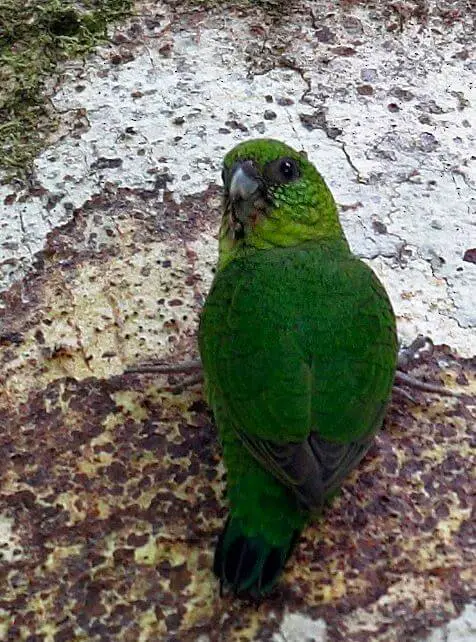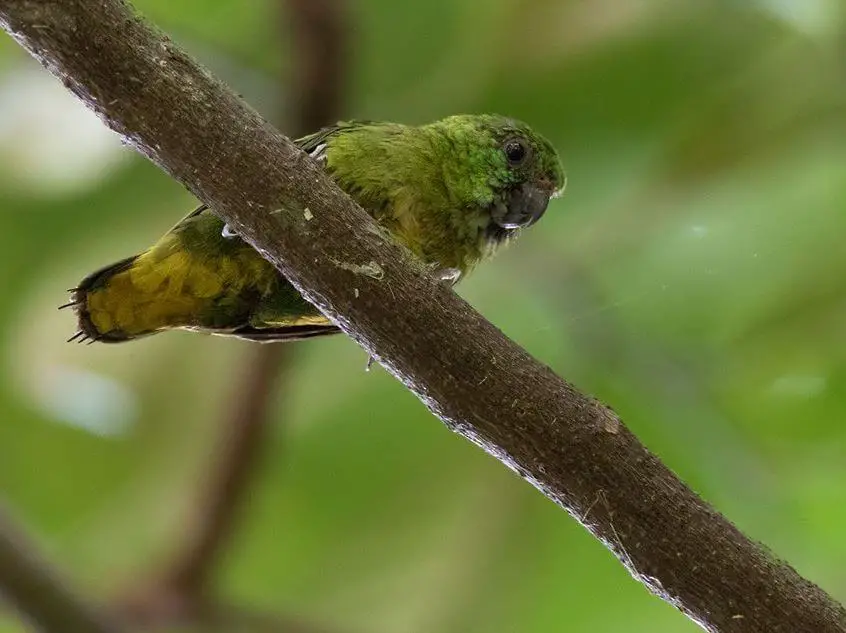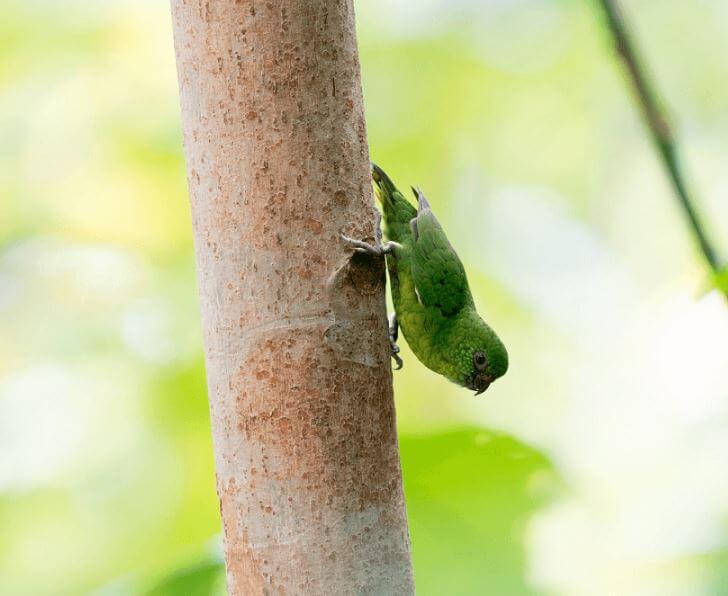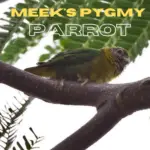
Finsch’s Pygmy-Parrot 8–9 cm; 12–18 g. Green throughout, paler on underparts; vague blue around the base of lower mandible; black spotting on median wing-coverts; belly spot orange-red; under tail-coverts yellow; tail greenish-blue centrally, black laterally.
The Female Finsch’s Pygmy-Parrot has pink around the base of the lower mandible, with no belly spot. Immature similar. Race alone darker above, with a blue patch on the crown and no belly spot;
Tristram like nominate without belly spot; nanina like aolae but with less blue on the crown; viridifrons like aolae with more blue on crown extending onto sides of the head, sometimes also with red belly spot.
Micropsitta finschii Scientific name definitions
- LC Least Concern
- Names (14)
- Subspecies (5)
Systematics History
Editor’s Note: This article requires further editing work to merge existing content into the appropriate Subspecies sections. Please bear with us while this update takes place.
Five subspecies were recognized.
Subspecies
SUBSPECIES
Micropsitta finschii viridifrons Scientific name definitions
Distribution
New Hanover, New Ireland, Djaul, Tabar Is and Lihir Is.
SUBSPECIES
Micropsitta finschii nanina Scientific name definitions
Distribution
N Solomon Is (Buka, Bougainville, Choiseul and Santa Isabel).
SUBSPECIES
Micropsitta finschii tristrami Scientific name definitions
Distribution
W Solomon Is (Vella Lavella, Gizo, Kolombangara, New Georgia, Rendova, Tetepare and Vangunu).
SUBSPECIES
Micropsitta finschii aolae Scientific name definitions
Distribution
EC Solomons (Russell Is, Guadalcanal, Florida Is and Malaita).
SUBSPECIES
Micropsitta finschii finschii Scientific name definitions
Distribution
SE Solomons on Rennell, Makira (San Cristobal) and Uki.
Distribution
Editor’s Note: Additional distribution information for this taxon can be found in the ‘Subspecies’ article above. In the future we will develop a range-wide distribution article.

Habitat
Chiefly primary forest but also second growth, shade trees, and trees in clearings between 500–1000 m, possibly lower, but in S Bougainville largely confined to sub-canopy and substage of unmossed primary forest with an open understorey at 600–750 m;
in E Solomons generally occurs up to cloud forest were replaced by M. bruijnii, but different altitude limits at which birds become rare noted for Kolombangara (490 m) and San Cristobal (900 m). Occasionally frequents coconut groves and casuarinas.
Diet and Foraging
The Finsch’s Pygmy-Parrot feed on relatively clear trunks and limbs of trees, pecking off bark and pieces of fungus and lichen; remains of small-scaled insects found alongside indeterminate vegetable matter in stomachs. Some parrots were noted apparently following slow-moving mixed bird flocks.
Sounds and Vocal Behavior

Finsch’s Pygmy-Parrot
Finsch’s Pygmy-Parrot Calls include high-pitched short notes such as “tsit” or “tsee”. Also short phrases involve several different notes, ranging from a disyllabic “see-sit” to a much longer “tsi-see-tsee-see-sit”.
Breeding
Mar-Apr, Guadalcanal. Reported to nest in low arboreal or terrestrial termite mound.
Conservation Status

Finsch’s Pygmy-Parrot
Conservation status on BirdlifeLC Least Concern
Not globally threatened. CITES II. A BirdLife “restricted-range” species. Fairly common, Bismarcks, and throughout most of Solomons although affected by forest loss on Guadalcanal.
Abundant within narrow elevation range, S Bougainville. On Kolombangara densities are much higher in lowland primary forest than secondary growth.




















